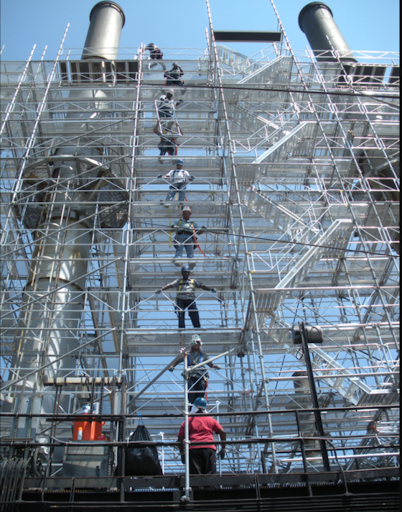Temporary Roof Scaffolding for Your Construction or Renovation Project
Temporary Roof Scaffolding for Your Construction or Renovation Project
Blog Article
Discovering the Numerous Sorts Of Scaffolding Used in Building Jobs
The building market depends greatly on numerous kinds of scaffolding to satisfy specific job demands, each offering distinct benefits and applications. Traditional frame scaffolding offers a tough structure for general tasks, while put on hold scaffolding is important for deal with skyscraper structures. Various other choices, such as system and rolling scaffolding, deal with efficiency and mobility, respectively. The cantilever alternative proves indispensable in city environments where area is constricted. Understanding the nuances of these scaffolding kinds is important for optimizing safety and security and efficiency on building sites, motivating a more detailed evaluation of their one-of-a-kind qualities and applications.

Standard Framework Scaffolding
Conventional framework scaffolding is among the most extensively used techniques in the building and construction sector because of its effectiveness and adaptability. This system contains straight and vertical structures that are constructed to create a steady system for products and employees. The main parts consist of vertical blog posts, horizontal journals, and angled braces, which with each other provide a strong framework that can support considerable lots.
Among the crucial benefits of traditional structure scaffolding is its flexibility to different building and construction projects, varying from property buildings to large industrial frameworks. The modular layout enables simple setting up and disassembly, making it effective for both lasting and temporary projects. Additionally, the system can be personalized in height and width, fitting different structure designs and site problems.
Safety is paramount in scaffolding applications, and traditional structure systems are geared up with guardrails and toe boards to prevent falls and guarantee worker protection. Regular evaluations and adherence to security policies are critical in preserving the integrity of the scaffold (Scaffolding). Overall, traditional framework scaffolding stays an essential choice in the building market, supplying a dependable platform for labor and boosting overall job effectiveness

Suspended Scaffolding
Suspended scaffolding supplies a special option for building and construction tasks that call for access to raised surfaces, particularly in circumstances where conventional structure scaffolding may be impractical. This sort of scaffolding is normally suspended from the roofing system or upper degrees of a structure, utilizing a system of pulley-blocks, systems, and ropes to develop a working room that can be readjusted to numerous elevations.
One of the key advantages of put on hold scaffolding is its flexibility. It can be conveniently repositioned or decreased to accommodate adjustments in construction needs, making it optimal for jobs such as window installment, frontage job, and maintenance on skyscrapers. Furthermore, the very little footprint of put on hold scaffolding enables better use of ground room in urban settings, where space is commonly limited.
Security is an important consideration in the use of put on hold scaffolding. Correct rigging and securing systems must be utilized to ensure security and prevent crashes. Operators must likewise be educated in the risk-free use this tools. In general, suspended scaffolding provides a efficient and efficient service for accessing hard-to-reach locations in numerous construction scenarios, boosting both performance and security on website.
System Scaffolding
System scaffolding, frequently considered as a contemporary service in the scaffolding market, includes pre-engineered elements that can be swiftly assembled and adapted for different construction projects. Scaffolding. This sort of scaffolding is defined by its modular design, which enables for convenience and efficiency on work sites, fitting architectural needs and various heights
Generally made from high-strength redirected here steel or light weight aluminum, system scaffolding supplies enhanced toughness and stability. The components consist of vertical articles, straight ledgers, and angled braces, which adjoin safely, ensuring a robust framework. The style frequently includes standard installations, streamlining setting up and disassembly procedures, thereby minimizing labor time and prices.

Rolling Scaffolding
Moving scaffolding is a versatile choice to traditional fixed scaffolding, designed for wheelchair and ease of use on construction websites. This kind of scaffolding contains a system supported by frameworks with wheels, permitting workers to easily relocate it as required. The flexibility feature dramatically enhances efficiency, as it decreases downtime connected with setting up and dismantling taken care of scaffolding.
Generally constructed from light-weight materials such as light weight aluminum or steel, rolling scaffolding uses a sturdy yet mobile service for jobs calling for constant repositioning - Scaffolding. It is especially advantageous in jobs such as painting, drywall setup, and electrical work, where accessibility to numerous elevations and places is necessary
Safety is paramount in rolling scaffolding design, with attributes such as locking wheels to protect against unexpected movement when in operation, and guardrails to shield employees from falls. Furthermore, several versions are adjustable in height, suiting numerous job requirements.
Cantilever Scaffolding

The design of cantilever scaffolding generally involves using braces or arms secured to a building or framework, allowing the system to expand outward securely. Safety and security is vital; therefore, these scaffolds should be crafted to stand up to various loads and environmental problems. Normal assessment and maintenance are crucial to make certain architectural integrity and employee safety and security.
Cantilever scaffolding is favored for its versatility and efficient use of space, making it a prominent choice in urban atmospheres where area restraints are typical. It assists in easier accessibility to high elevations, eventually contributing to the overall performance of building tasks. As with all scaffolding kinds, correct training and adherence to safety and security requirements are vital for workers using cantilever scaffolding.
Final Thought
In final thought, the diverse sorts of scaffolding made use of in building and construction projects each serve unique functions tailored to details site demands. Conventional framework scaffolding offers stability, while put on hold scaffolding offers convenience for elevated jobs. System scaffolding promotes quick setting up, and rolling scaffolding boosts mobility for differing job environments. Cantilever scaffolding efficiently resolves challenges in city setups. Recognizing these scaffolding kinds is vital for enhancing safety and security and performance in building and construction, inevitably adding to the effective completion of tasks.
Traditional structure scaffolding offers a sturdy foundation for general tasks, while look at here now suspended scaffolding is essential for job on high-rise frameworks.Moving scaffolding is a flexible choice to conventional fixed scaffolding, made for flexibility and ease of usage on building sites. As with all scaffolding kinds, correct training and adherence to security criteria are important for workers using cantilever scaffolding.
Typical structure scaffolding supplies security, while suspended scaffolding offers flexibility for raised tasks. System scaffolding assists in quick assembly, and rolling scaffolding enhances wheelchair for differing job atmospheres.
Report this page